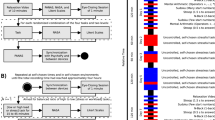Abstract
The article provides information on the CAPTIV wireless sensor system and its use in measuring the response of the human nervous system to stress caused by manual manipulation of loads of varying weight. This tool of modern ergonomics serves to gather data for subsequent analysis of stress put on psychophysiological functions of a person. In the article, you can find information on measurement results from individual sensors and the interdependence between the level of stress put on a person and the amount of the organism’s response to said stress. Used in the tests were the T-Sens GSR sensors for measuring the galvanic skin conductivity and a T-Sens HRM sensors for measuring heart rate. The data obtained from the sensors were then transformed, compared and evaluated in order to find dependence between the subjective reaction to the stress of the person monitored and the objective levels of stress induced.
Access this chapter
Tax calculation will be finalised at checkout
Purchases are for personal use only
Similar content being viewed by others
References
Vignais, N., Bernard, F., Touvenot, G., Sagot, J.C.: Physical risk factors identification based on body sensor network combined to videotaping. Appl. Ergon. 65, 410–417 (2017). https://doi.org/10.1016/j.apergo.2017.05.003
Balog, A.: Psychoterapia, Biofeedback (Inst. 2016-08-10). http://www.mindandbody.sk/vas-doktor/psychoterapia-biofeedback-attila-balog
Kuric, I., Bulej, V., Saga, M., Pokorný, P.: Development of simulation software for mobile robot path planning within multilayer map system based on metric and topological maps. Int. J. Adv. Robot. Syst. 14(6) (2017). ISSN 1729-8814
Krajcovic, M., Plinta, D.: Comprehensive approach to the inventory control system improvement. Manag. Prod. Eng. Rev. 3(3), 34–44 (2012). ISSN 2082-1344
Krkoska, L., Gregor, M., Matuszek, J.: Simulation of human effect to the Adaptive Logistics System used in public facilities. Procedia Eng. 192, 492–497 (2017). https://doi.org/10.1016/j.proeng.2017.06.085
Uusitalo, A., Mets, T., Martinmaki, K., Mauno, S., Kinnunen, U., Rusko, H.: Heart rate variability related to effort at work. Appl. Ergon. 42, 830–838 (2011). https://doi.org/10.1016/j.apergo.2011.01.005
Visnovcova, Z., Tonhajzerova, I.: Biomedicinsky princip a vyuzitie elektrodermalnej odpovede v klinickej praxi. Cogn. Remediat. J. (2013)
Gasova, M.: Modern methods in ergonomics research and european legislation. In Advanced industrial engineering – new approaches in production management, Monograph (Dariusz Plinta), Publisher: Publ. House of Center for New Technologies Foundation, Bielsko Biala, pp. 147–164 (2015). ISNB 978-83-927531-7-9
Cook, D.J., Song, W.: Ambient intelligence and wearable computing: Sensors on the body, in the home, and beyond. J. Ambient Intell. Smart Environ. 1(2), 83–86 (2009)
Acknowledgement
This paper is supported by the following project: University Science Park of the University of Zilina – II. phase (ITMS: 313011D013) supported by the Operational Programme Research and Innovation funded by the European Regional Development Fund and by VEGA project [1/0936/16] entitled Using tools of digital factory for development of ergonomic prevention programs.
Author information
Authors and Affiliations
Corresponding author
Editor information
Editors and Affiliations
Rights and permissions
Copyright information
© 2019 Springer Nature Switzerland AG
About this paper
Cite this paper
Dulina, L., Kramarova, M., Cechova, I., Wiecek, D. (2019). Using Modern Ergonomics Tools to Measure Changes in the Levels of Stress Placed on the Psychophysiological Functions of a Human During Load Manipulations. In: Burduk, A., Chlebus, E., Nowakowski, T., Tubis, A. (eds) Intelligent Systems in Production Engineering and Maintenance. ISPEM 2018. Advances in Intelligent Systems and Computing, vol 835. Springer, Cham. https://doi.org/10.1007/978-3-319-97490-3_48
Download citation
DOI: https://doi.org/10.1007/978-3-319-97490-3_48
Published:
Publisher Name: Springer, Cham
Print ISBN: 978-3-319-97489-7
Online ISBN: 978-3-319-97490-3
eBook Packages: Intelligent Technologies and RoboticsIntelligent Technologies and Robotics (R0)




